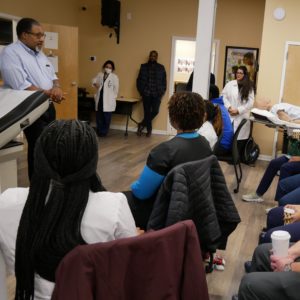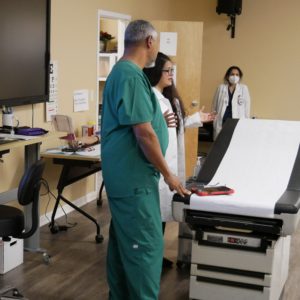Letter from Provost: Musings on Assisting with Air Travel Medical Emergencies
A recent airline emergency at 30,000 feet, prompted the airline crew to request the assistance of any doctor on board. I have had this experience once in the past, in 1993 while traveling from Phoenix, AZ to Chicago, IL. I was traveling with my wife and family of two young toddler children. After ringing the call bell, the flight attendant questioned my background, including having to provide proof of state medical licenses, American Board of Emergency Medicine Certification, and employment status. After satisfying their scrutiny, I was allowed to spend the remainder of the flight on the floor with an elderly female who was suffering from a hypoglycemic episode.
The medical kit that was provided to me was scant. At that time there was no AED, there were an oxygen cylinder and face mask, an AMBU bag, some over the counter medications; Tylenol, Advil, a sphygmomanometer, a stethoscope, I.V. administration set: 1 tubing with 2 Y-site connectors, 2 alcohol-soaked sponges, a roll of 1-inch-wide adhesive tape, 1 pair of tape scissors, and 1 tourniquet.
Protective nonpermeable gloves or equivalent, 1 pair, 50% dextrose, epinephrine injection 1mg/ml, diphenhydramine injection and nitroglycerin tablets.
The Federal Aviation Administration (FAA) has required since 2004 an automated external defibrillator (AED) be present on board.
The FAA has also proposed a list of minimum contents for emergency medical kits to be included on all flights in 2001. Should be noted that these kits are much improved over what was provided to me in 1993.
It should also be recognized that medical professionals who volunteer to provide in-flight assistance, need to be qualified, active, licensed and sober. A recent publication noted that “more than 4 billion passengers are expected to fly in 2019, and more than 60,000 medical emergencies are anticipated.”
The current contents of an FAA Approved Emergency Medical Kit includes:
Sphygmomanometer
Stethoscope
Airways, oropharyngeal: 1 pediatric, 1 small adult, and 1 large adult or equivalent
Self-inflating manual resuscitation device with 1 pediatric mask, 1 small adult mask, and 1 large adult or equivalent mask
Cardiopulmonary resuscitation masks: 1 pediatric, 1 small adult, and 1 large adult or equivalent
V. administration set: 1 tubing with 2 Y-site connectors, 2 alcohol-soaked sponges, 1 standard roll of 1-inch-wide adhesive tape, 1 pair of tape scissors, and 1 tourniquet
Protective nonpermeable gloves or equivalent, 1 pair
Needles: 2 18 gauge, 2 20 gauge, and 2 22 gauge; or 6 needles in sizes necessary to administer required medications
Syringes: 1 5 cc and 2 10 cc; or 4 syringes in sizes necessary to administer required medications
Analgesic, nonnarcotic, 325-mg tablets, 4
Antihistamine, 25-mg tablets, 4
Antihistamine injection, 50-mg single-dose ampule or equivalent, 2
Atropine injection, 0.5-mg single-dose 5-mL ampule or equivalent, 2
Aspirin, 325-mg tablets, 4
Bronchodilator, metered-dose inhaler or equivalent
50% Dextrose injection, single-dose 50-mL ampule or equivalent
Epinephrine injection, 1:1000 (1 mg/mL) single-dose 1-mL ampule or equivalent, 2
Epinephrine injection, 1:10,000 (0.1 mg/mL) single-dose 2*-mL ampule or equivalent, 2
Lidocaine injection, 20-mg/mL single-dose 5-mL ampule or equivalent, 2
Nitroglycerin, 0.4-mg tablets, 10
9% Sodium chloride injection, 500 mL
Basic instructions for use of the drugs in the kit
One would ponder are there legal ramifications of providing medical assistance during a flight? Nable et al. reported in the New England Journal of Medicine,” that providing care creates a doctor-patient relationship with its attendant obligations and liability risk. Liability is usually determined under the law of the country in which the aircraft is registered. “Nable goes on to state;” U.S. health care providers traveling on registered U.S. airlines have no legal obligation to assist in the event of a medical emergency, ethical obligations often prevail. Some countries including Australia and other European countries impose a legal obligation to assist.
Congress passed the Aviation Medical Assistance Act (AMAA) in 1998. This provides protection to providers who assist in in-flight medical emergencies from liability. Although a number of caveats are important to recognize. The AMAA does allow liability of providers if the provider was grossly negligent or flagrantly disregarded the patient’s health safety.
It is recommended that the provider provide written documentation of the care provided.
The most common in-flight emergencies include chest pain, syncope, asthma attack, head injury secondary to overhead luggage falling from storage bins, psychiatric problems (anxiety/phobias), abdominal illnesses such as diarrhea and pain, diabetic-related emergencies, allergic reactions, obstetric and gynecological emergencies. Although not all doctors are trained to treat all possible emergencies, however, a good rule of thumb keeps in mind “primum non nocere.”
For our Canadian students in training, “there were 133.4 million airline passengers in 2015, a 27.3% increase from 2009.” Kodama ET. Al. In addition to the increase in passenger traffic, there has been a significant increase in the number of passengers taking longer flights, subjecting patients to physiologic stressors, relative hypoxia and lower humidity. Delaney et al. recently reported that respiratory viruses are not spread through recirculated air on commercial flights, only approximately 50% of the air is recirculated and that all air is HEPA filtered. (EM Practice 09/19)
Ground-based medical consulting companies exist and are often contracted by major airlines to provide consultation when needed. Their primary role is to assist in medical decision-making and advising. Estimates as high as $100,000 is the potential cost to an airline that is diverted because of an ill passenger. In addition, to the logistics of re-routing new flights for passengers, possible hotel and meal accommodation can be arduous.
For me, after spending almost 3 hours on the floor with my ill patient, who did well and was transported to hospital after arriving in Chicago. I was met at the door by the flight attendant when departing, and “was thanked for the help.” My wife who I abandoned with our two small children, was left to attend to their needs on her own.
Don W. Penney MD.MSC.FACEP.FAAEM.


